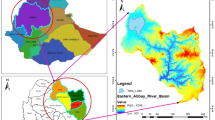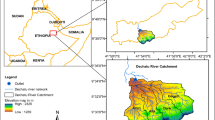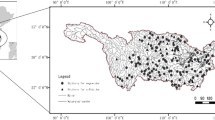Abstract
For various reasons, it is not always possible to obtain adequate and reliable long-term streamflow records in a river basin. It is known that streamflow records are even shorter when the stations located on tributary channels are of the interest. Hence, it is necessary to develop dependable streamflow estimation models for the tributary streams that play a key role in the micro-hydrology of the basin. In this study, rainfall-runoff models are developed to estimate the daily streamflow in ungauged tributary streams. Precipitation and streamflow in the most similar gauging station on the main channel and lagged values up to three days before on the same tributary station are used as the input variables of the allocated models. To select the most similar gauging station, a similarity index criterion is developed and used in the analysis. Then, two scenarios based on the streamflow or the corresponding set of direct runoff and base-flow in the same station are used. By applying multivariate adaptive regression spline (MARS) and random forest (RF) methods, several rainfall-runoff models are developed and evaluated based on determination coefficient, mean absolute percentage error, root mean square error, relative peak flow, scatter plot and time series plot. Alternatively, the MARS and RF models are combined with a drainage area ratio (DAR) model to produce the DAR-MARS and DAR-RF models. It is concluded that the direct runoff in the mainstream is more effective on the streamflow of the tributary station, while the integration of models with DAR enhanced the capabilities of the models in estimation of extreme values in the streamflow time series.



Similar content being viewed by others
Data Availability
The data used in this study can be provided by the corresponding author through a reasonable and formal request.
References
Abbasi, M., Farokhnia, A., Bahreinimotlagh, M., & Roozbahani, R. (2021). A hybrid of Random Forest and Deep Auto-Encoder with support vector regression methods for accuracy improvement and uncertainty reduction of long-term streamflow prediction. Journal of Hydrology, 597, 125717.
Adnan, R. M., Liang, Z., Heddam, S., Zounemat-Kermani, M., Kisi, O., & Li, B. (2020). Least square support vector machine and multivariate adaptive regression splines for streamflow prediction in mountainous basin using hydro-meteorological data as inputs. Journal of Hydrology, 586, 124371.
Adnan, R. M., Yuan, X., Kisi, O., & Anam, R. (2017). Improving accuracy of river flow forecasting using LSSVR with gravitational search algorithm. Advances in Meteorology, 20, 17.
Al-Sudani, Z. A., Salih, S. Q., & Yaseen, Z. M. (2019). Development of multivariate adaptive regression spline integrated with differential evolution model for streamflow simulation. Journal of Hydrology, 573, 1–12.
Araza, A., Hein, L., Duku, C., Rawlins, M. A., & Lomboy, R. (2020). Data-driven streamflow modelling in ungauged basins: regionalizing random forest (RF) models. bioRxiv.
Arsenault, R., & Brissette, F. P. (2014). Continuous streamflow prediction in ungauged basins: The effects of equifinality and parameter set selection on uncertainty in regionalization approaches. Water Resources Research, 50(7), 6135–6153.
Asquith, W.H., Roussel, M.C., & Vrabel, J. (2006). Statewide analysis of the drainage-area ratio method for 34 streamflow percentile ranges in Texas. US Geological Survey. Scientific Investigations Report 2006-5286.
Belabid, N., Zhao, F., Brocca, L., Huang, Y., & Tan, Y. (2019). Near-real-time flood forecasting based on satellite precipitation products. Remote Sensing, 11(3), 252.
Bhandari, S., Thakur, B., Kalra, A., Miller, W. P., Lakshmi, V., & Pathak, P. (2019). Streamflow forecasting using singular value decomposition and support vector machine for the upper Rio Grande River Basin. JAWRA Journal of the American Water Resources Association, 55(3), 680–699.
Bitew, M. M., Gebremichael, M., Ghebremichael, L. T., & Bayissa, Y. A. (2012). Evaluation of high-resolution satellite rainfall products through streamflow simulation in a hydrological modeling of a small mountainous watershed in Ethiopia. Journal of Hydrometeorology, 13(1), 338–350.
Breiman, L. (2001). Random forests. Machine Learning, 45(1), 5–32.
Box, G. E. P., Jenkins, G. M., & Reinsel, G. C. (2008). Time series analysis, forecasting and control (4th ed.). Wiley. ISBN 9780470272848.
Burn, D. H., & Boorman, D. B. (1993). Estimation of hydrological parameters at ungauged catchments. Journal of Hydrology, 143(3–4), 429–454.
Camici, S., Ciabatta, L., Massari, C., & Brocca, L. (2018). How reliable are satellite precipitation estimates for driving hydrological models: A verification study over the Mediterranean area. Journal of Hydrology, 563, 950–961.
Emerson, D. G., Vecchia, A. V., & Dahl, A. L. (2005). Evaluation of drainage-area ratio method used to estimate streamflow for the Red River of the North Basin, North Dakota and Minnesota. US Geological Survey. Scientific Investigations Report 2005-5017.
Farmer, W. H., & Vogel, R. M. (2013). Performance-weighted methods for estimating monthly streamflow at ungauged sites. Journal of Hydrology, 477, 240–250.
Fathian, F., Mehdizadeh, S., Sales, A. K., & Safari, M. J. S. (2019). Hybrid models to improve the monthly river flow prediction: Integrating artificial intelligence and non-linear time series models. Journal of Hydrology, 575, 1200–1213.
Friedman, J. H. (1991). Multivariate adaptive regression splines (with discussion). The Annals of Statistics, 19(1), 1–141.
Ghoddusi, H., Creamer, G. G., & Rafizadeh, N. (2019). Machine learning in energy economics and finance: A review. Energy Economics, 81, 709–727.
Hastie, T., Tibshirani, R., & Friedman, J. (2009). The elements of statistical learning. Springer.
Heddam, S., & Kisi, O. (2018). Modelling daily dissolved oxygen concentration using least square support vector machine, multivariate adaptive regression splines and M5 model tree. Journal of Hydrology, 559, 499–509.
Jiang, D., & Wang, K. (2019). The role of satellite-based remote sensing in improving simulated streamflow: A review. Water, 11(8), 1615.
Jiang, L., & Bauer-Gottwein, P. (2019). How do GPM IMERG precipitation estimates perform as hydrological model forcing? Evaluation for 300 catchments across Mainland China. Journal of Hydrology, 572, 486–500.
Kashani, M. H., Ghorbani, M. A., Dinpashoh, Y., & Shahmorad, S. (2016). Integration of Volterra model with artificial neural networks for rainfall-runoff simulation in forested catchment of northern Iran. Journal of Hydrology, 540, 340–354.
Kneis, D., Chatterjee, C., & Singh, R. (2014). Evaluation of TRMM rainfall estimates over a large Indian river basin (Mahanadi). Hydrology and Earth System Sciences, 18(7), 2493–2502.
Kumar, A., Ramsankaran, R. A. A. J., Brocca, L., & Muñoz-Arriola, F. (2021). A simple machine learning approach to model real-time streamflow using satellite inputs: Demonstration in a data scarce catchment. Journal of Hydrology, 595, 126046.
Mehr, A. D., & Kahya, E. (2017). A Pareto-optimal moving average multigene genetic programming model for daily streamflow prediction. Journal of Hydrology, 549, 603–615.
Mehr, A. D., Safari, M. J. S., & Nourani, V. (2021). Wavelet packet-genetic programming: A new model for meteorological drought hindcasting. Teknik Dergi, 32(4), 11029–11050.
Mohammadi, B., Linh, N. T. T., Pham, Q. B., Ahmed, A. N., Vojteková, J., Guan, Y., Abba, S. I., & El-Shafie, A. (2020). Adaptive neuro-fuzzy inference system coupled with shuffled frog leaping algorithm for predicting river streamflow time series. Hydrological Sciences Journal, 65(10), 1738–1751.
Mohammadi, B., Safari, M. J. S., & Vazifehkhah, S. (2022). IHACRES, GR4J and MISD-based multi conceptual-machine learning approach for rainfall-runoff modeling. Scientific Reports, 12(1), 1–21.
Nayak, P. C., Sudheer, K. P., & Jain, S. K. (2007). Rainfall-runoff modeling through hybrid intelligent system. Water Resource Research, 43, 7.
Razavi, T., & Coulibaly, P. (2016). Improving streamflow estimation in ungauged basins using a multi-modelling approach. Hydrological Sciences Journal, 61(15), 2668–2679.
Ries, K. G. & Friesz, P. J. (2000). Methods for estimating low-flow statistics for Massachusetts streams. US Geological Survey. Scientific Investigations Report 4135.
Safari, M. J. S. (2019). Decision tree (DT), generalized regression neural network (GR) and multivariate adaptive regression splines (MARS) models for sediment transport in sewer pipes. Water Science and Technology, 79(6), 1113–1122.
Safari, M. J. S. (2020). Hybridization of multivariate adaptive regression splines and random forest models with an empirical equation for sediment deposition prediction in open channel flow. Journal of Hydrology, 590, 125392.
Safari, M. J. S., Arashloo, S. R., & Mehr, A. D. (2020). Rainfall-runoff modeling through regression in the reproducing kernel Hilbert space algorithm. Journal of Hydrology, 587, 125014.
Samadianfard, S., Kargar, K., Shadkani, S., Hashemi, S., Abbaspour, A., & Safari, M. J. S. (2022). Hybrid models for suspended sediment prediction: Optimized random forest and multi-layer perceptron through genetic algorithm and stochastic gradient descent methods. Neural Computing and Applications, 34(4), 3033–3051.
Samuel, J., Coulibaly, P., & Metcalfe, R. A. (2011). Estimation of continuous streamflow in Ontario ungauged basins: Comparison of regionalization methods. Journal of Hydrologic Engineering, 16(5), 447–459.
Shiri, J. (2018). Improving the performance of the mass transfer-based reference evapotranspiration estimation approaches through a coupled wavelet-random forest methodology. Journal of Hydrology, 561, 737–750.
Su, F., Hong, Y., & Lettenmaier, D. P. (2008). Evaluation of TRMM multisatellite precipitation analysis (TMPA) and its utility in hydrologic prediction in the La Plata Basin. Journal of Hydrometeorology, 9(4), 622–640.
Tan, S. B., Chua, L. H., Shuy, E. B., Lo, E. Y. M., & Lim, L. W. (2008). Performances of rainfall-runoff models calibrated over single and continuous storm flow events. Journal of Hydrologic Engineering, 13(7), 597–607.
Tang, X., Zhang, J., Gao, C., Ruben, G. B., & Wang, G. (2019). Assessing the uncertainties of four precipitation products for SWAT modeling in Mekong River Basin. Remote Sensing, 11(3), 304.
Tongal, H., & Booij, M. J. (2018). Simulation and forecasting of streamflows using machine learning models coupled with base flow separation. Journal of Hydrology, 564, 266–282.
TSMS (2021), Turkish State Meteorological Service. www.mgm.gov.tr.
Waseem, M., Ajmal, M., & Kim, T. W. (2015). Ensemble hydrological prediction of streamflow percentile at ungauged basins in Pakistan. Journal of Hydrology, 525, 130–137.
Vaheddoost B., & Aksoy H. (2019). Evaluation of base flow index in stream flows of the Lake Urmia Basin using one parameter digital filter method. The 1st International and 4th National Congress on Iranian Irrigation and Drainage, November 13–14. Urmia University, Urmia, Iran.
Yang, X., Magnusson, J., Rizzi, J., & Xu, C. Y. (2018). Runoff prediction in ungauged catchments in Norway: Comparison of regionalization approaches. Hydrology Research, 49(2), 487–505.
Yao, D., Yang, J., & Zhan, X. (2013). A novel method for disease prediction: Hybrid of random forest and multivariate adaptive regression splines. Journal of Computers, 8(1), 170–177.
Yilmaz, A. G., & Muttil, N. (2014). Runoff estimation by machine learning methods and application to the Euphrates Basin in Turkey. Journal of Hydrologic Engineering, 19(5), 1015–1025.
Yilmaz, M. U., & Onoz, B. (2019). Evaluation of statistical methods for estimating missing daily streamflow data. Teknik Dergi, 30(6), 9597–9620.
Yilmaz, M. U., & Onoz, B. (2020). A comparative study of statistical methods for daily streamflow estimation at ungauged Basins in Turkey. Water, 12(2), 459.
Yilmaz, M. U., & Onoz, B. (2022). Development of ensemble approaches based on performance of statistical methods for daily streamflow estimation. Hydrological Sciences Journal. https://doi.org/10.1080/02626667.2022.2072735
Zelelew, M. B., & Alfredsen, K. (2014). Transferability of hydrological model parameter spaces in the estimation of runoff in ungauged catchments. Hydrological Sciences Journal, 59(8), 1470–1490.
Zhao, W., Sánchez, N., Lu, H., & Li, A. (2018). A spatial downscaling approach for the SMAP passive surface soil moisture product using random forest regression. Journal of Hydrology, 563, 1009–1024.
Zhou, J., Peng, T., Zhang, C., & Sun, N. (2018). Data pre-analysis and ensemble of various artificial neural networks for monthly streamflow forecasting. Water, 10(5), 628.
Acknowledgements
The authors express their gratitude to the General Directorate of State Hydraulic Works of Turkey (DSI in Turkish acronym) and the Turkish State Meteorological Service (MGM in Turkish acronym) for providing the data used in this study. We also want to thank the Editor and anonymous reviewers who helped us in enhancing the scientific quality of the article.
Author information
Authors and Affiliations
Corresponding author
Ethics declarations
Conflict of interest
The authors declare that they have no conflict of interest.
Additional information
Publisher's Note
Springer Nature remains neutral with regard to jurisdictional claims in published maps and institutional affiliations.
Rights and permissions
Springer Nature or its licensor (e.g. a society or other partner) holds exclusive rights to this article under a publishing agreement with the author(s) or other rightsholder(s); author self-archiving of the accepted manuscript version of this article is solely governed by the terms of such publishing agreement and applicable law.
About this article
Cite this article
Vaheddoost, B., Safari, M.J.S. & Yilmaz, M.U. Rainfall-Runoff Simulation in Ungauged Tributary Streams Using Drainage Area Ratio-Based Multivariate Adaptive Regression Spline and Random Forest Hybrid Models. Pure Appl. Geophys. 180, 365–382 (2023). https://doi.org/10.1007/s00024-022-03209-3
Received:
Revised:
Accepted:
Published:
Issue Date:
DOI: https://doi.org/10.1007/s00024-022-03209-3




